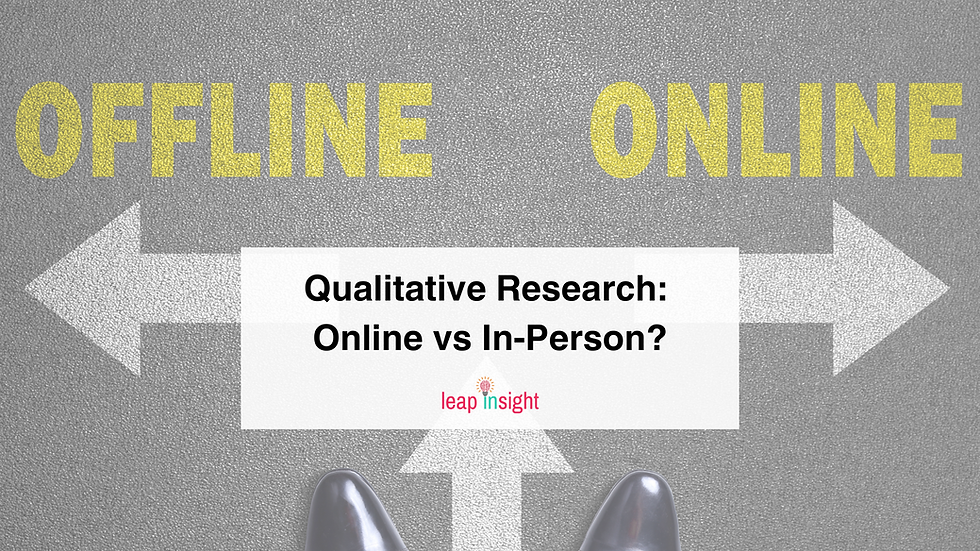Qualitative Research - Online vs In Person?
- sharlenezeederberg
- Aug 5
- 3 min read
Updated: Aug 5
Benefits, pros and cons of choosing online vs in-person qual sessions
Covid opened the door to greater use and acceptance of online tools for conducting interviews and group discussions.
There are benefits to both types, and what you use when depends on task, logistics and budget considerations.
Here we break down the advantages and disadvantages of doing qualitative research in-person compared to online.

Differences in Efficiency & Logistics
Online focus groups and IDIs (Zoom, Microsoft Teams, Google Meet) — key advantages
Broader reach and faster recruitment. Geography is no longer a constraint; you can recruit niche or hard‑to‑reach segments across multiple time zones within days rather than weeks.
Lower cost. No venue hire, travel, catering, or printed stimulus. Budget can shift to incentives or additional sample cells.
Scheduling flexibility. Evening or early‑morning sessions become viable, boosting show‑rates.
Rapid client observation. Stakeholders can silently drop in via virtual back‑room links without the expense of a one‑way mirror facility.
Central‑venue (in‑person) research — logistical advantages
Controlled environment. Reliable Wi‑Fi, professional recording gear, and tech support are built in.
Immediate hands‑on stimulus. Physical prototypes, packaging, or sensory products (taste, fragrance, textiles) are experienced as intended.
Relationship building. Moderators, observers, and participants mingle, generating spontaneous hallway insights and debrief energy.
Key disadvantages
Differences in Participant Experience & Engagement
Online
Comfort and anonymity. Many respondents feel safer sharing sensitive views from their own space; shy personalities flourish.
Digital stimulus integration. Screen‑share for ad concepts, websites, and journey maps is seamless.
But: Eye‑tracking body language is harder; side‑conversations and crosstalk can collapse into audio clutter.
In‑Person
Richer non‑verbal cues. A skilled moderator can read micro‑expressions, posture shifts, and group energy, probing in real time.
Dynamic group chemistry. Physical presence builds rapport, allowing spontaneous brainstorming on flip charts or sticky walls.
But: Some participants may feel self‑conscious in a mirrored room, inhibiting disclosure.
Differences in Data Quality & Analytical Depth
Practical & Ethical Considerations
Accessibility & inclusion. Online sessions welcome parents with childcare duties, people with disabilities, or rural residents. Venues can meet accessibility standards, yet long commutes may deter participation.
Privacy & consent. Virtual platforms require explicit consent for cloud recording; researchers must comply with GDPR/APPs and ensure secure storage. In‑person requires visible signage and secure file transfer of large video files.
Technology proficiency. Elderly or low‑tech audiences may struggle with virtual waiting rooms; in‑venue staff can provide immediate assistance.
Choosing the Right Modality
Use online qualitative research when:
Speed‑to‑insight and national reach are critical.
Budgets are tight but sample diversity matters.
Prototypes are digital or can be mailed in advance.
Stakeholders need to observe discreetly from multiple locations.
Respondents are hard to reach, high status or the topics are sensitive
Opt for central‑venue / in-home sessions when:
Tactile, sensory, or large‑format stimuli must be experienced live.
Group dynamics and non‑verbal communication are important.
Extended co‑creation, journey mapping, or design‑thinking workshops are planned.
Security for confidential products or advertising is paramount.
Conclusion
Neither modality is inherently “better.” Instead, align research objectives, participant needs, and practical constraints to the channel. By understanding the nuanced trade‑offs outlined above, insight teams and agencies like Leap Insight can deliver robust, timely, and cost‑effective qualitative findings—no matter where the conversation happens.







Comments